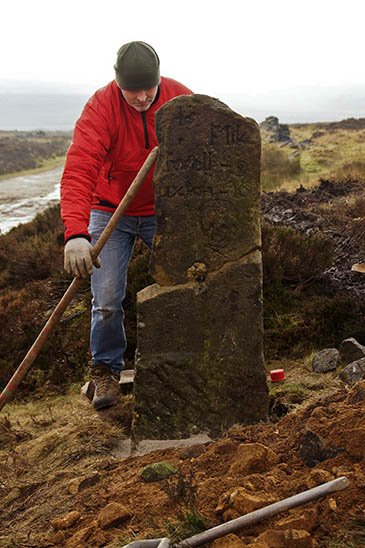
National park ranger Tom Lewis secures the centuries-old milestone back on its base after nearly 70 years
A historic milestone that was removed from a Peak District moor so as not to aid invading Nazis during the Second World Way has been restored to its rightful place.
The 18th century turnpike milestone spent 70 years adorning a garden in Dore on the outskirts of Sheffield.
It had been stacked with a pile of stones and other material from a dismantled mock town that was constructed on Houndkirk Moor as a night-time decoy to draw German bombers away from the industrial works in Sheffield.
Some of the stones were used in rockeries in post-war houses in Dore, including one owned by David Harrison.
At a charity open gardens event, it was spotted by a member of Sheffield Time Travellers archaeology group and Mr Harrison decided the stone, with a unique skull and crossbones carving, should be replace on the moor.
Peak District national park rangers and members of the Time Travellers, used stainless steel rods and resin to secure it in place.
The authority said the milestone probably originated sometime after 1767 when such posts were made compulsory to guide travellers on turnpikes. It has the distances to Sheffield on one side, and to Tideswell and Buxton on the other, with the skull and crossbones carved underneath – no-one knows why.
Bill Gordon, national park estate ranger for nearby North Lees, said: “It brings great joy to re-unite a piece of history with the area it came from.
“It’s part of the moor’s unique cultural heritage and we’re very grateful to David Harrison and the Time Travellers that it’s been saved for posterity.”
Mr Harrison said he was thrilled that others will now be able to appreciate the full stretch of milestones from the Norfolk Arms right through to Longshaw.
John Colby
02 March 2014There's skull and crossbones graves in many places - in Cornwall some say that they're the graves of pirates, but they also occur in inland locations. Another theory is that they're plague victims. As for certainty - there isn't any.